engine BUICK ROADMASTER 1993 User Guide
[x] Cancel search | Manufacturer: BUICK, Model Year: 1993, Model line: ROADMASTER, Model: BUICK ROADMASTER 1993Pages: 340, PDF Size: 18.34 MB
Page 131 of 340
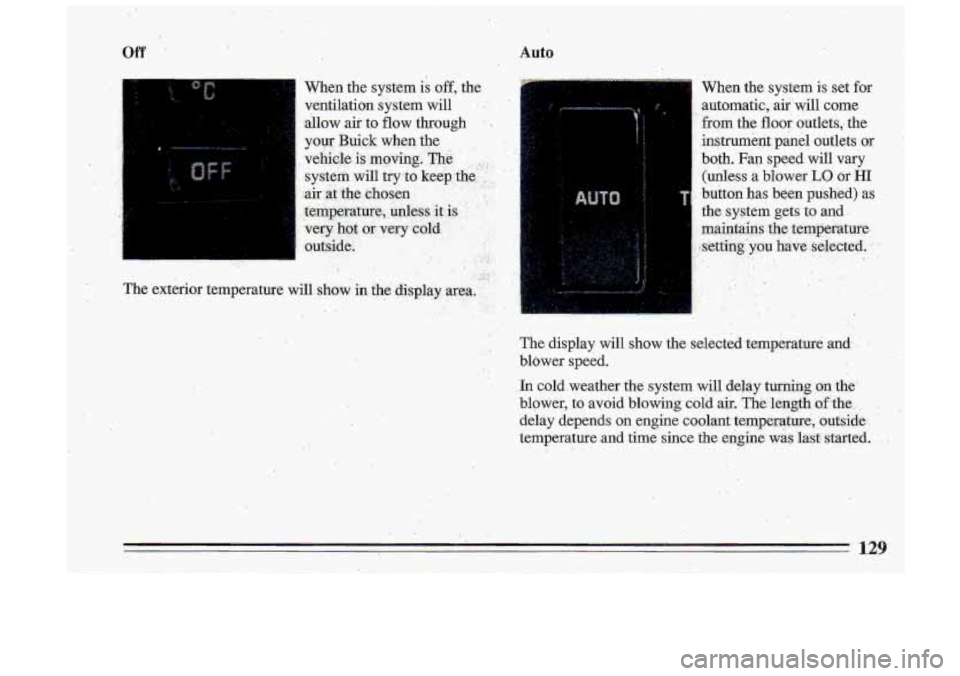
Off Auto
When the system is off; the
.. .. . . ..
When the system is set for
automatic, aitwill come
from the
floor o,utlets,. the
instrument panel outlets or
both. Fan speed
will vary
(unless
a blower LO or HI
'. bukon has been pushed) as
the system gets
to and
m,aintaigs the temperature
'; .setting'you have .selected:
The display will show the selected,temperature and ,
.In cold .weather the system will delay. turning on the'
blower, to avoid blowing cold air.
The length ofthe.
delay depends
on engine coolant temperature, .outside
temperature
and time since the engine was last: stafted.
'. , blower speed.
Page 135 of 340
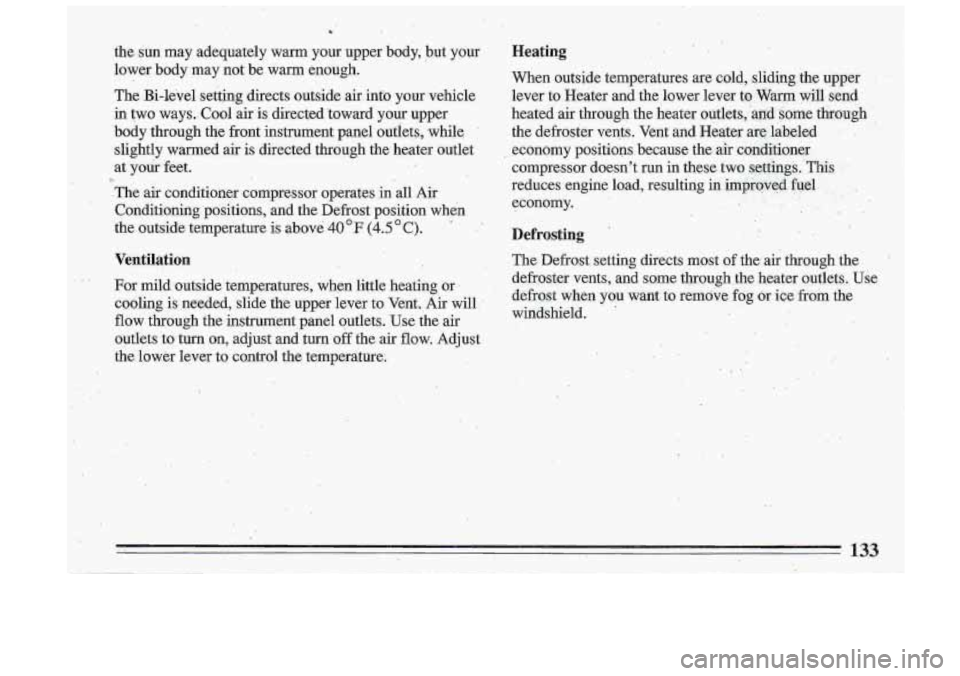
i
the sun may adequately warm your upper body, but your
lower body may not be warm enough.
The Bi-level settbg directs outside air.into your vehicle
in two ways.-Cool air
is directed 'toward your upper
body through the front instrument panel outlets, ,while
slightly warmed
air is directed through the heater outlet
at
your feet.
.The air conditioner compressor operates in all Air
Conditioning positions, and the Defrost position when
.the outside temperature is above
40 OF (4.5 C).
R
Ventilation
For mild outside temperatures, when little heating ox ,
cooling is needed, slide the upper lever to Vent, Air will,'
flow through the .instrument panel outlets. Use the air
oudets to turn on, adjust and turn
off the air, flow. Adjust.
the lower lever to control the temperature;
'.
.. .
Heating
When outside temperatures are cold, 8liding:the upper .
lever to Heater and the' lower lever to :Warm will send,
heated air though the heater outlets, 'and-some through
the defroster vents. Vent and Heater arelabeled
economy positions. because the
dr conditioner
compres.sor doesn't run in these..two settings. "This . .
reduces engine load, resulting in impioyed I.. fyd.
economy.
Defrosting
The Defrost setting directs most of the- air through the
defroster vents, and some through.the heater outlets. Use
defrost when you want to remove fog
,6r ice from the
windshield.
133
Page 136 of 340
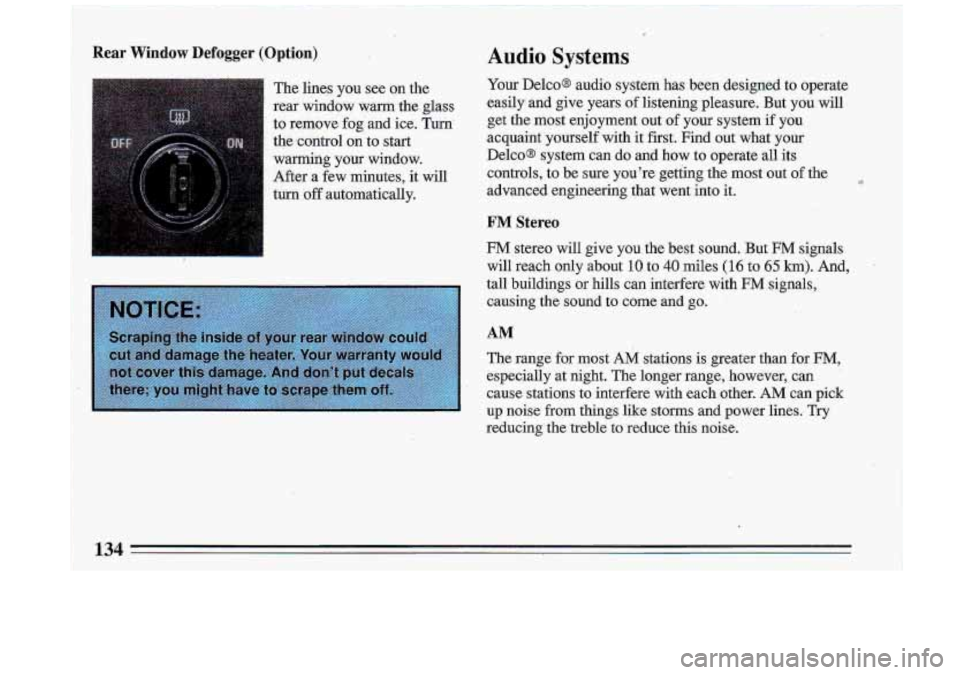
Rear Window Defogger (Option)
The lines you see on the
rear window warm the glass
to remove fog and ice. Turn'
the control on' to start
warming your window.
After
a few minutes; it will
turn off automatically.
Audio Sysxems
Your Delco@ audio system has been designed to uperate
easily and give years
-of listening pleasure. But you will
get the
most enjoyment out of your system if you
acquaint .yourself with it first. Find out what your
Delcos system can do and how to operate all its
controls, to be sure you're getting the most out
sf the
advanced engineering that went into
it.
FM Stereo
FM stereo will give you the best sound. But FM signals
will reach only about
10 to 40 miles (16 to 65 km). And,
tall buildings or hills can interfere with FM signals, causing the
sound to come and go.
AM
The range for most AM stations is greater than for FM,
especially at night. The longer range, however, can
cause stations to interfere with each other.
AM can pick
up noise from things like storms and power lines. Try
reducing the treble
to reduce this noise.
Page 167 of 340
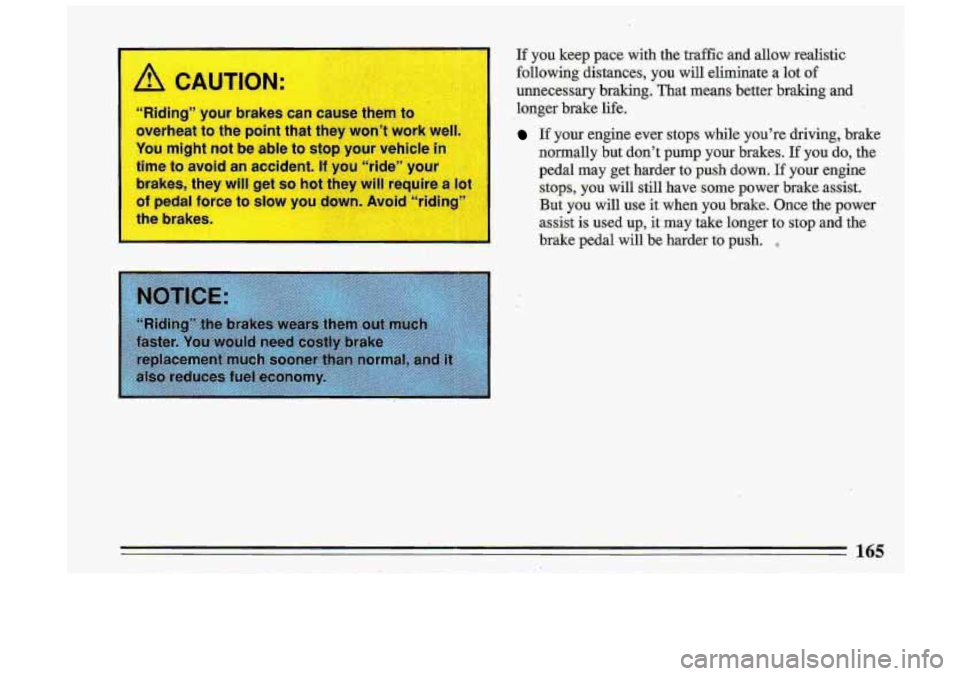
Riding” your brake
overheat to the point that they won’t work well,
You might not be able to stop your vehicle
it
time to avoid an accident. If you “ride” your
brakes, they will get
so hot they will require a 1st
of pedal force to slow you down. Avoid “ridil
the brakes.
If you keep pace with the traffic and al1,ow realistic
followirig distance.s, you will eliminate a lot
of
unnecessary braking. ‘That means better braking and
longer brake
life.
If your engine ever stops while you’re driving, brake
normally .but don’t
pump your brakes. If you do, the
pedal may get harder to push down.
If your engine
stops, you will still have some power brake. assist.
But you will use it when you brake. Once.the power
assist
is used up, it-may take longer to stop and the
brake pedal
will be harder to push.
165
Page 171 of 340
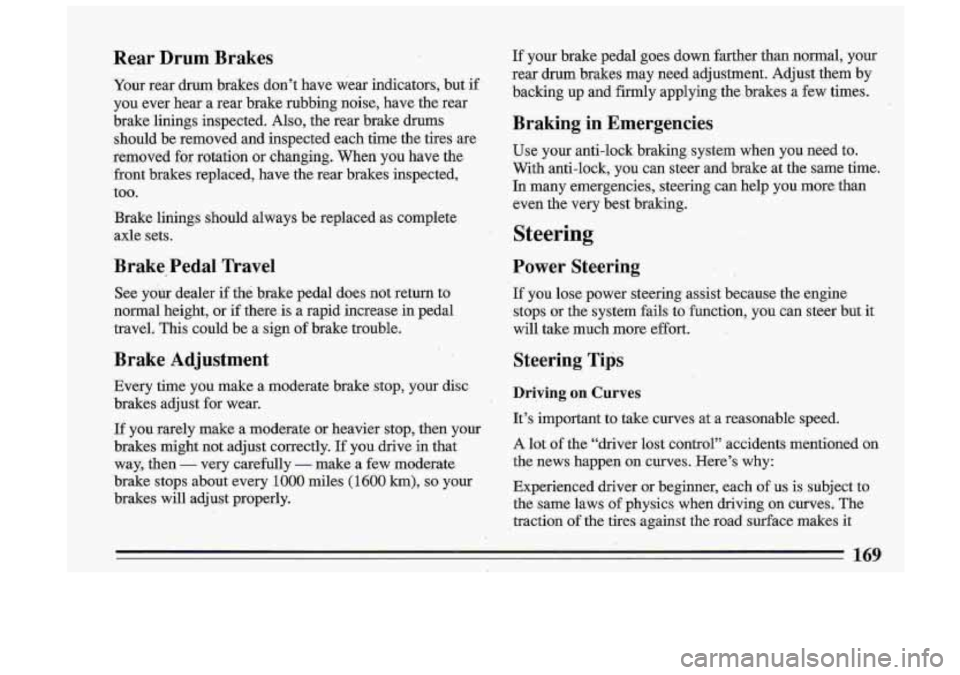
If your brake pedal goes down farther man normal, your
rear drum brakes may need adjustment. Adjust them by
backing
up and firmly applying the brakes a few times.
I
Braking in Emergencies I
Use your anti-lock braking sysKem when you need to. .
With anti-lock, you can steer and brake at the same time.
In many emergencies, steering can help you .more. than
even the very best braking.
Steering
Power Steering
If you lose power steering a ssist becau Lse
the engine
stops or the system fails to function, you can steer but
it
will take much more effort.
Steering Tips
Driving on Curves
It’s important to take- curves at a reasonable speed.
A lot of the “driver lost control” accidents mentioned on
the news happen on curves. Here’s why:
Experienced driver or beginner, each
of us is subject to
the same laws of physics. when driviqg on curves. The
traction
of the tires agairist the road s.urface makes it
169
Page 188 of 340
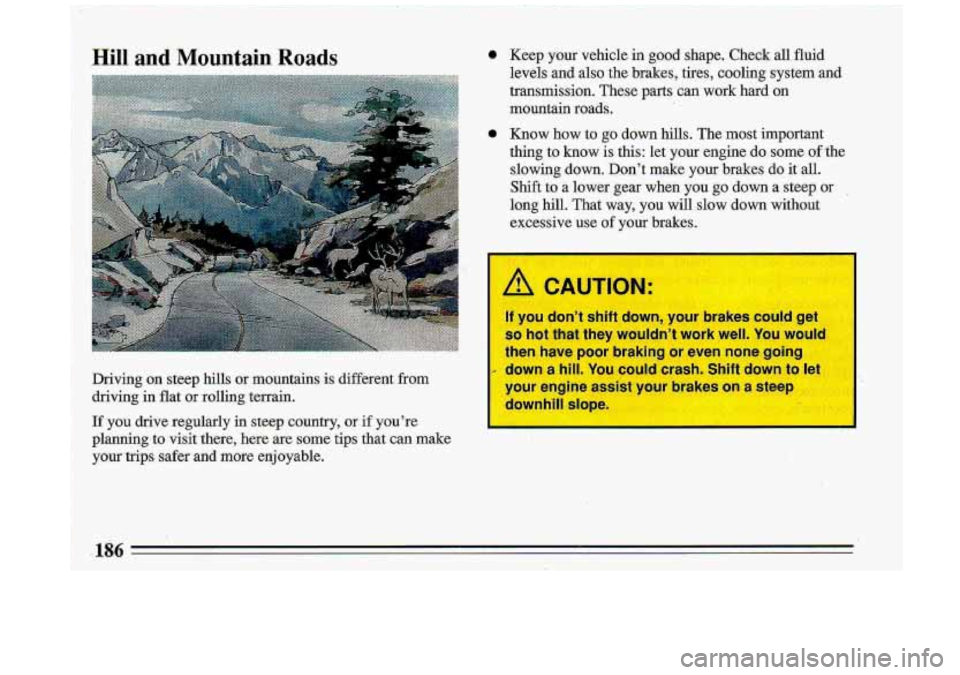
Driving on steep hills or mountains is different from
driving in
flat or rolling terrain.
' A CAUTION:
If you don't shift down, your brakes could get
o hot that they wouldn't work well. You wou.,
..len have
poor braking or even none going
. down a hill. You could crash. Shift dowr tn Ifit
,our engine assist vnur brakes on a stec,
down hill slope.
If you drive regularly in steep country, or if you're - - -
planning-to visit there, here are some tips that can make
your
trips safer and more enjoyable.
Page 193 of 340
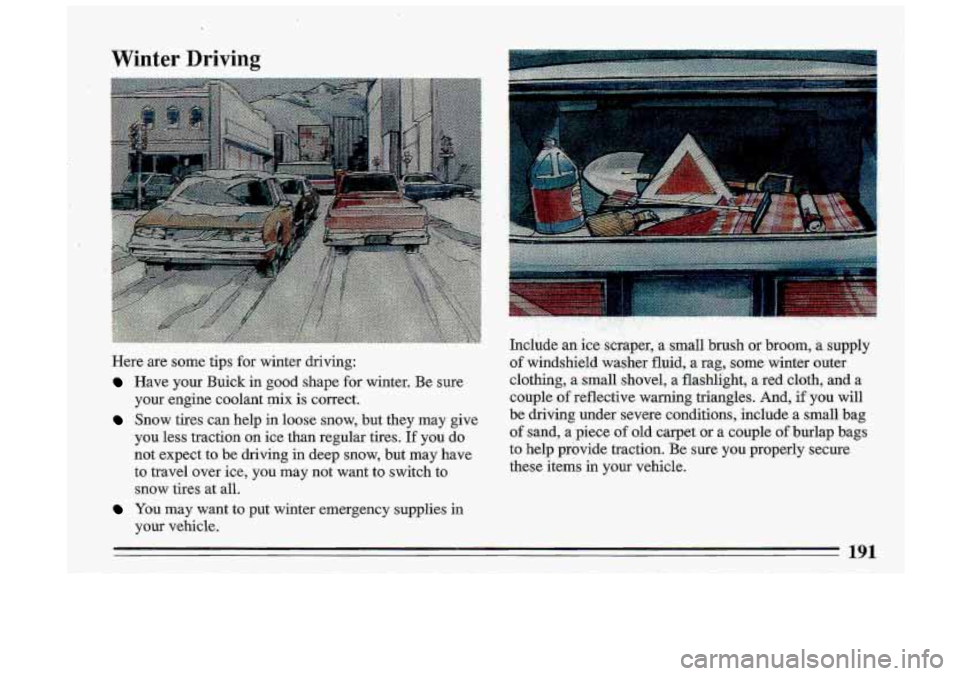
Winter Driving
Here are some tips for winter driving:
Have your Buick in good shape for winter. Be sure
your engine coolant mix is co-rrect.
Snow tires. can help in loose snow, but they may give
you less traction on ice than regular tires. If you do
not expect to be driving
in deep snow, but may have
to travel over ice,
you may not want to switch to
snow tires at all.
You may want to put winter emergency supplies in
your vehicle.
I
I
.. . ..
Include an.ice:scrapGq a small brush .or broom, a supply
of'windshield washer fluid,
a rag, some winter outer
clothing,
a small shovel, a flashlight, a, red. cloth,. and a
couple
.of reflective warning triangles. And, if you will
be driving under:severe conditions, include a small bag
of sand, a piece of ,old carpel .or a couple of burlap. bags
to help provide traction. Be sure y.ou properly secure
these items in your vehicle.
Page 196 of 340
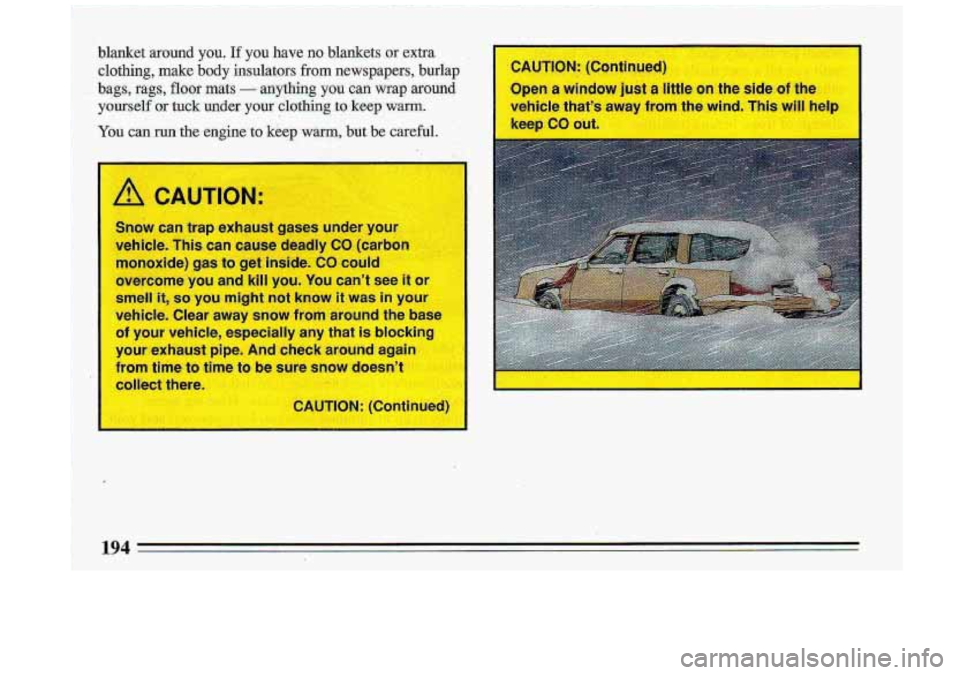
blanket around you. If you have no blankets or extra. II
clothing, make body insulators. from newspapers, burlap I CAUTION: (Continued)
bags, rags, floor math - anything you can wrap around 3pen a window just a Iihz oh &he side of the
yourself OX tuck under your clothing to keep warm. ._ .. ,... r’ ,. . I vehicle that’s away from the wind. This will helr
Yon can run the engine to keep warm, but. be careful.
,. ,
/A CAUTION:
Snow can trap exhaust gases under your
vehicle. This can
cause deadly CO (carbnn
monoxide)
gas to get inside. CQ could
overcome you and kill you. You can’t see it o
smell it, so y~u might not know it was in you1
vehicle. Clear
away snow from around the base
of your vehicle, especially any that is blockina
your exhaust
gibe. And check around again
from time to ti P to be sure snow doesn’t
collect there.
CAUTION: (Continued)
Page 197 of 340
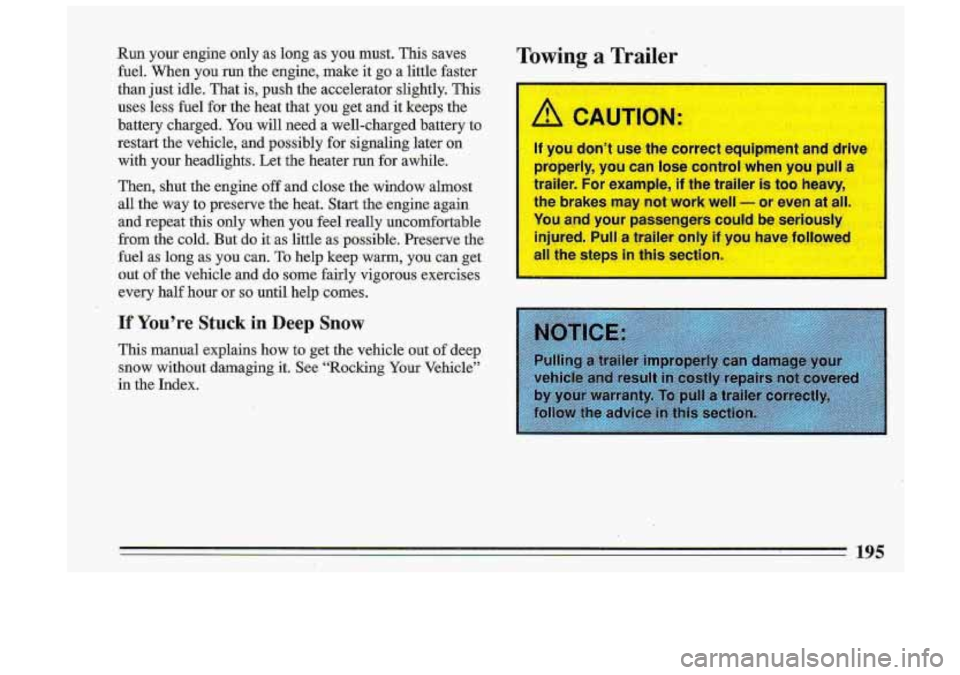
Run your engine only as long as you must. This saves
fuel. When you
run the engine, make it go a little faster
than just idle. That is, push the accelerator slightly. This:
uses less fuel for the heat that you get and it keeps the
battery charged.
You will need a well-charged battery to
restart the vehicle, and possibly for signaling later
on
with your headlights. Let the heater run for awhile.
Then, shut the engine
off and close the window almost
all the way to preserve the heat. Start the engine again
and repeat this only when you feel really uncomfortable
from the cold. But do
it as 'little as possible. Preserve the
fuel
as long as you can. To help keep warm, you can get
out of the vehicle and
do some fairly vigorous exercises
every half hour or
so until help comes.
Towing, a Trailer
/! CAUTION-
If you don't use the correct equipment and drive
properly, you can lose control when you
pull a
trailer.
For example, if the trailer is too heavy,
I the brakes may not work well - or even at all,
You and your passengers could be seriously'
injured. Pull
a trailer only if you have followed
I the steps in this section.
Page 205 of 340
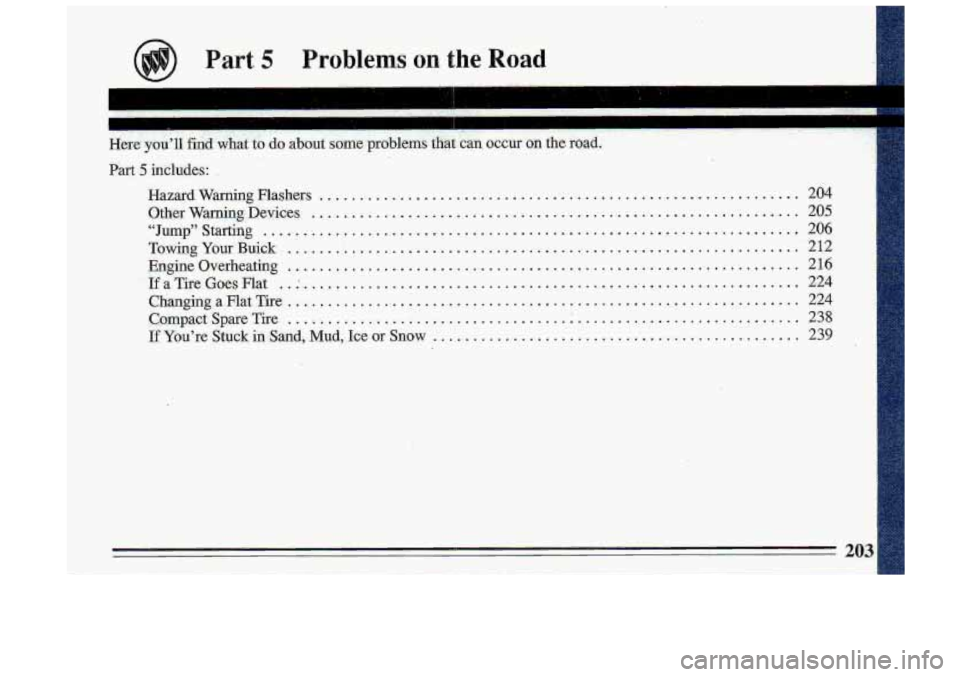
Part 5 Problems on the Road
I- .. . 1. ’ . ’ ‘I
.. .....
Here you’ll find what to do about some problems that can occur on the road .
Part 5 includes:
Hazard Warning Flashers
............................................................
“Jump”Starting ...................................................................
OtherWarningDevices .............................................................
TowingYourBuick ................................................................
Engineoverheating ................................................................
IfaTireGoesFlat .................................................................
ChangingaFlatTire ................................................................
CompactSpareTire ................................................................
If You’re Stuck in Sand, Mud, Ice or Snow ..............................................
204
205
206
212
216
224
224
238
239